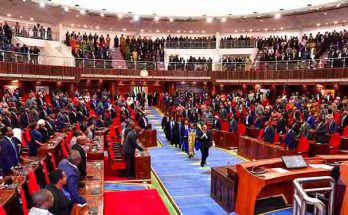
At present, there is little automotive manufacturing on the continent anywhere between South Africa and North Africa, with the exception of Nigeria. Such assembly plants are a decent halfway house between having no automotive industry and full-scale manufacturing. They are much easier to develop and it is far quicker to train workers.
The German company began production at its Kenyan facility, at Thika just outside Nairobi, in January, 40 years after it closed its original Kenyan plant. The new factory receives part assembled Polos and Vivos from Volkswagen South Africa’s (VWSA) Uitenhage assembly plant in the Eastern Cape for final assembly. It will handle 1,000 cars this year, increasing over time to 5,000 units.
Announcing the launch in Nairobi, VWSA managing director and chairperson Thomas Schäfer said: “We believe that Kenya has got the potential to develop a very big fully-fledged automotive industry. The East African Community has got the potential, and today is the first step in this direction that we want to take with our passenger cars.”
Other companies, such as Toyota, Nissan and Mitsubishi already have similar facilities in Kenya, mainly producing buses and trucks rather than cars. Total production stands at about 10,000 units a year, according to the Kenya Vehicle Manufacturers Association (KVMA).
VWSA is also in talks with the government of Rwanda over opening a similar facility there. As in Kenya it would be a joint venture with the government. Schäfer said: “We have not settled on a model yet. Once we do, we will work out the details. In principle, it could be possible to start vehicle assembly in Rwanda by the end of 2017.”
Volkswagen also plans to launch a ride-hailing service, along the same lines as Uber, in Rwanda, possibly using an electric version of the Golf.
Creating a market
At present, much of Africa relies on imported used vehicles, with Japanese cars particularly popular in Anglophone Africa because they offer left-hand drive. Apart from South Africa and the North African states, new car sales are very low in most of Africa.
One of the biggest obstacles to greater new vehicle sales is the lack of access to finance and high interest rates even where loans are available. Production usually follows demand but VW is clearly banking on creating a market for its vehicles.
It followed the same strategy in Latin America, particularly in Mexico. The company wants to strengthen its position in emerging markets and forecasts that total vehicle sales in East Africa will increase by 40% over the next five years. It is considering setting up similar plants to the one in Kenya in Ethiopia and Tanzania.
Ethiopia already produces about 8,000 vehicles a year using imported kits in very small plants. Chinese firm Lifan has production capacity of 5,000 cars a year but assembles just 900. Car ownership in the country is very low, partly because of high taxes on imports, but in 2016 110,000 cars were imported, marking an increase of 50% on 2015.
At the Nairobi launch, Schäfer said: “VW global headquarters in Germany wouldn’t look twice at the numbers we are talking about in African countries, but you have to take a long-term view. In Africa, you never go from A to B in a straight line.”
However, the importance of Africa to the company’s global strategy was demonstrated in March when it announced the formation of a Sub-Saharan region to develop the African market. The region will be headed by Schäfer.
Developments in South Africa
A Chinese state-owned firm, Beijing Automotive International Corporation (BAIC), signed a deal last August to set up a new car plant in Coega Industrial Zone in South Africa’s Eastern Cape at a cost of R11bn ($870m). Trade and industry minister Rob Davies said that the Eastern Cape was “an automotive hub and has the potential of deepening the component supply chain, job creation and economic development.”
BAIC, which is the fourth biggest automotive producer in China, holds a 65% stake in the project, with the remainder held by Industrial Development Corporation, a state-owned South African company. The factory will produce cars from kits shipped to Coega’s port of Ngqura from China. The first vehicles are due to roll off the production line in 2018, with output gradually ramped up to 100,000 a year by 2027.
South African vehicle manufacturing capacity has grown markedly in recent years. Pretoria designated the automotive industry a priority area for investment a decade ago, offering tax and other financial incentives to investors.
BMW, Ford and Toyota have all increased their operations in the country over the past few years. South Africa exported 173,000 vehicles to Europe in 2016, up from 116,000 in the previous year, and the National Association of Automobile Manufacturers of South Africa forecasts that production will rise by 48% to 900,000 units a year by 2020.
VWSA is investing R4.5bn in South Africa to increase Uitenhage’s annual production capacity from 120,000 to 180,000 units, including the new versions of the Polo and Vivo.
Output increases in Morocco
Morocco has followed a similar pattern to South Africa, offering incentives for foreign companies and developing Tanger Med as an export port for the sector. As a result, output increased from 100,000 vehicles in 2012 to 348,000 in 2016.
Domestic sales are increasing rapidly, with 13,782 new registrations in January, up 22% on the same month last year. Crucially, retailers offer finance to support their marketing campaigns.
A total of 316,000 vehicles were exported in 2016, up 22.4% on the previous year and this trend is likely to continue. Peugeot is building a new €557m plant in the Atlantic Free Zone of Kenitra with annual production of 90,000 units, later increasing to 200,000.
Foreign and Moroccan component manufacturers are increasing their capacity to serve the growing sector. Governments in sub-Saharan Africa hope that they will experience the same benefits of agglomeration if their small automotive industries are able to grow in the same way.



